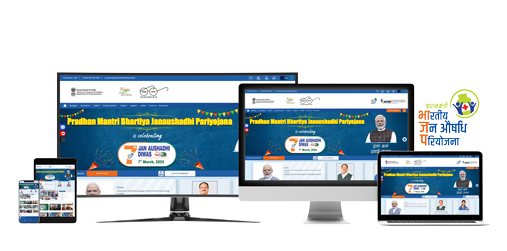
Pradhan Mantri Bhartiya Jan Aushadhi Pariyojna (PMBJP)
Type: Turnkey IT Solution
Technology: .NET Framework, Android, Angular, PHP
Ethics Infotech developed a comprehensive IT solution for the Pradhan Mantri Bhartiya Jan Aushadhi Pariyojna (PMBJP), revolutionizing the pharmaceutical supply chain in India. The solution encompasses vendor and supplier management, a robust transportation portal, a centralized ERP system, barcode-enabled warehouse management, advanced DPOS and POS systems, and a user-friendly mobile application. By leveraging cutting-edge technology, we ensured transparency, efficiency, and cost reduction throughout the supply chain. This initiative has significantly improved the accessibility and affordability of essential medicines for millions of Indians.
OBJECTIVES
Marketing Objectives
Increase awareness of Jan Aushadhi Kendras: Promote the availability of affordable generic medicines to the target population.
Drive foot traffic to Jan Aushadhi Kendras: Encourage people to visit and purchase medicines from these outlets.
Build trust and credibility: Position the PMBJP as a reliable source of quality and affordable healthcare.
Collaborate with government agencies: Partner with relevant departments to promote the scheme.
Technical Objectives
Improve inventory management accuracy: Implement advanced inventory control techniques to minimize stockouts and overstocks.
Optimize logistics and transportation: Utilize route optimization algorithms to reduce delivery costs and time.
Integrate with government healthcare systems: Connect the PMBJP system with relevant government databases for seamless data exchange.
Implement robust security measures: Protect sensitive patient data and financial transactions from cyber threats.
Ensure system scalability: Design the system to handle the increased demand and expansion of Jan Aushadhi Kendras.
Project Outcomes
Enhanced accessibility to affordable medicines: Increased availability of generic medicines through a wider network of Jan Aushadhi Kendras.
Improved affordability of healthcare: Significant cost savings for patients by providing medicines at affordable prices.
Strengthened supply chain efficiency: Optimized logistics, inventory management, and distribution processes.
Improved drug availability: Reduced stockouts and ensured timely supply of essential medicines.
Enhanced patient satisfaction: Increased satisfaction with the availability and affordability of medicines.
Strengthened public-private partnerships: Successful collaboration with pharmaceutical companies and retailers.
Positive impact on public health: Contributed to improved health outcomes for the population.
Project Challenges
Integration of diverse systems: Seamlessly integrating various components of the supply chain, including vendor management, transportation, warehousing, and retail, posed significant challenges.
Data management and security: Ensuring the accuracy, integrity, and security of vast amounts of sensitive patient and financial data was critical.
Supply chain disruptions: Managing unforeseen disruptions, such as natural disasters, pandemics, or supply shortages, requires robust contingency plans.
Last-mile delivery challenges: Ensuring timely and efficient delivery of medicines to remote and underserved areas presented logistical hurdles.
Quality control and counterfeit prevention: Maintaining stringent quality control measures to prevent the distribution of counterfeit or substandard medicines.
Stakeholder management: Coordinating with multiple stakeholders, including government agencies, pharmaceutical companies, distributors, and retailers, required effective communication and collaboration.
Technology adoption: Overcoming resistance to change and ensuring smooth adoption of new technologies among stakeholders.